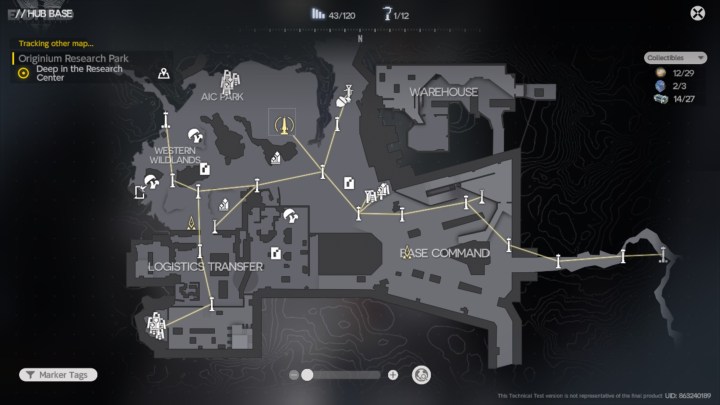
I knew nothing about Arknights before starting Gryphline’s spinoff, Arknights: Endfield. When I saw the opportunity to participate in the technical test, the name reappeared in my mind like a vague vision of something I’d seen in a showcase like The Game Awards. Ultimately, I decided to try it because of the appealing graphics and action promised in its promotional materials.
I was not disappointed.
Gryphline’s flagship title is Arknights, a tower defense game known for its challenging strategy and rich worldbuilding. Like many mobile games, it includes a gacha mechanic that lets players obtain new anime characters. Endfield is lightly based on the same premise, but there isn’t enough overlap for it to be necessary to play the original Arknights. Think Honkai Impact 3rd versus Genshin Impact: It might be cool to know Yae Sakura for the added context when you meet her Genshin counterpart, but you don’t need that information to enjoy either game.
I expected Endfield to land between the middling “Genshin clones” I’d played, but I was pleasantly surprised to find a competent action RPG with building mechanics that set it apart from competitors. If you want a game that balances building, story, and combat on a silver platter, this one might be for you.
Beware of the info dump
Endfield‘s most glaring flaw is its slow start. Its story and gameplay are initially disorienting, if only because it isn’t clear what you should be doing outside of following the main quest.
I spend my first few moments in a dreamlike tutorial, memorizing movement and attack controls. Then, my character wakes up to a lengthy history lesson about Endfield ‘s world in a couple-minute cutscene. The history of the world, the role of the Endministrator, and the current dangers the characters are facing are all crammed into that intro. I don’t even remember half of it because it was so much dense information at once.
After that, I get to the meat of the issue: My character, a technology savant called the Endministrator, suffers from amnesia following an accident involving a crashed cryopod. They’re deployed to find a MIA operator who might be able to help them recover their memories, but that thread is easy to lose in the questionable pacing.

Even 20 hours into my test, I was learning new information about how to optimize my character builds and make life easier for me as a player. For example, Endfield introduced me to relay towers to power electrical machines before I felt like I needed them. Later, I unlocked ziplines for more efficient travel and needed to build robust electrical networks with relay towers to make that happen. These are the kinds of logical connections you could only make after playing the game for hours.
Promising progression
I instinctively compare Endfield to Genshin Impact because of its open world and real-time action. But admittedly, it’s nothing like it besides a skeleton of mechanics found in many other mobile games. I control one character at a time during combat but can switch between companions at any point during a fight. AI controls the others. I needed to keep an eye on my teammates’ health bars to make sure they didn’t wipe out while I was learning how to time my skills properly.
At first, battles felt a bit easy. However, I noticed that surviving in Rifts at the recommended levels was difficult without effectively building and controlling characters. Rifts, dungeons that players need to fight through to earn leveling materials, offer different difficulty levels that only unlock after fighting through the previous one. For higher levels, I needed to stock up on healing equipment before entering. There isn’t a dodge button, and sprinting can only help so much when AI companions rush into danger.

Perhaps it’s because of my background with Genshin Impact and Honkai: Star Rail, but I enjoyed steadily strengthening my characters with the layers of leveling systems. I can upgrade weapons with “essences” that imbue them with special abilities and unlock combat bonuses on gear when enough pieces of the same set are equipped together. These qualities made me feel like I was progressing at each step of the way and that I could experiment with more than one set build for my characters.
World “building” also extends beyond story. Part of the main gameplay loop involves managing a base that automates farming and peppering the map with structures that make everything more convenient. I deployed rigs that automatically harvested ores and sent them to my depot and then programmed my machines to load those rocks onto a conveyor belt and process them into precious materials I needed for crafting. In other parts of the world, I created a trail of electric towers and used them to power ziplines that shot from one corner of the map to the other. These buildings were new to me as someone who had never touched Arknights, and I haven’t seen anything like them in any other RPGs I’ve played. Even better, they gave me a way to interact with Endfield‘s already beautifully rendered and geographically diverse world.

This technical test didn’t include any gacha components, only temporary access to a store that developers highlighted wouldn’t be in the final product. I could complete most of the content without any issues with just its free characters, and I didn’t even use any of the higher-rated units. Still, it’s difficult to judge how much the gacha system will affect the final product at this stage of development.
Either way, it’s a game I’m already itching to get back into as soon as possible. It’s too early to say if it’ll be able to compete with the likes of Genshin Impact, but the rewarding gameplay and intriguing premise are enough to keep it on my radar.
Arknights: Endfield is currently in development for PC, iOS, Android, and PlayStation 5.
Editors' Recommendations
- The best iPhone and Android apps for Black History Month 2024
- I record interviews for work. These are my favorite free recorder apps
- Ranking all 16 iOS versions, from worst to best
- Apple vs. Samsung: Who has the best lock screen customization in 2022?
- These 80+ apps could be running adware on your iPhone or Android device



